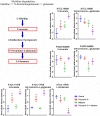Synergistic Killing of Polymyxin B in Combination With the Antineoplastic Drug Mitotane Against Polymyxin-Susceptible and -Resistant Acinetobacter baumannii: A Metabolomic Study
- PMID: 29713282
- PMCID: PMC5911485
- DOI: 10.3389/fphar.2018.00359
Synergistic Killing of Polymyxin B in Combination With the Antineoplastic Drug Mitotane Against Polymyxin-Susceptible and -Resistant Acinetobacter baumannii: A Metabolomic Study
Abstract
Polymyxins are currently used as the last-resort antibiotics against multidrug-resistant Acinetobacter baumannii. As resistance to polymyxins emerges in A. baumannii with monotherapy, combination therapy is often the only remaining treatment option. A novel approach is to employ the combination of polymyxin B with non-antibiotic drugs. In the present study, we employed metabolomics to investigate the synergistic mechanism of polymyxin B in combination with the antineoplastic drug mitotane against polymyxin-susceptible and -resistant A. baumannii. The metabolomes of four A. baumannii strains were analyzed following treatment with polymyxin B, mitotane and the combination. Polymyxin B monotherapy induced significant perturbation in glycerophospholipid (GPL) metabolism and histidine degradation pathways in polymyxin-susceptible strains, and minimal perturbation in polymyxin-resistant strains. Mitotane monotherapy induced minimal perturbation in the polymyxin-susceptible strains, but caused significant perturbation in GPL metabolism, pentose phosphate pathway and histidine degradation in the LPS-deficient polymyxin-resistant strain (FADDI-AB065). The polymyxin B - mitotane combination induced significant perturbation in all strains except the lipid A modified polymyxin-resistant FADDI-AB225 strain. For the polymyxin-susceptible strains, the combination therapy significantly perturbed GPL metabolism, pentose phosphate pathway, citric acid cycle, pyrimidine ribonucleotide biogenesis, guanine ribonucleotide biogenesis, and histidine degradation. Against FADDI-AB065, the combination significantly perturbed GPL metabolism, pentose phosphate pathway, citric acid cycle, and pyrimidine ribonucleotide biogenesis. Overall, these novel findings demonstrate that the disruption of the citric acid cycle and inhibition of nucleotide biogenesis are the key metabolic features associated with synergistic bacterial killing by the combination against polymyxin-susceptible and -resistant A. baumannii.
Keywords: combination therapy; metabolomics; mitotane; multidrug-resistance; polymyxin.
Figures









Similar articles
-
Mechanisms Underlying Synergistic Killing of Polymyxin B in Combination with Cannabidiol against Acinetobacter baumannii: A Metabolomic Study.Pharmaceutics. 2022 Apr 3;14(4):786. doi: 10.3390/pharmaceutics14040786. Pharmaceutics. 2022. PMID: 35456620 Free PMC article.
-
Comparative metabolomics reveals key pathways associated with the synergistic activity of polymyxin B and rifampicin combination against multidrug-resistant Acinetobacter baumannii.Biochem Pharmacol. 2021 Feb;184:114400. doi: 10.1016/j.bcp.2020.114400. Epub 2020 Dec 30. Biochem Pharmacol. 2021. PMID: 33387481 Free PMC article.
-
Novel Polymyxin Combination With Antineoplastic Mitotane Improved the Bacterial Killing Against Polymyxin-Resistant Multidrug-Resistant Gram-Negative Pathogens.Front Microbiol. 2018 Apr 12;9:721. doi: 10.3389/fmicb.2018.00721. eCollection 2018. Front Microbiol. 2018. PMID: 29706941 Free PMC article.
-
Polymyxin combination therapy for multidrug-resistant, extensively-drug resistant, and difficult-to-treat drug-resistant gram-negative infections: is it superior to polymyxin monotherapy?Expert Rev Anti Infect Ther. 2023 Apr;21(4):387-429. doi: 10.1080/14787210.2023.2184346. Epub 2023 Mar 8. Expert Rev Anti Infect Ther. 2023. PMID: 36820511 Review.
-
Synergistic combinations of polymyxins.Int J Antimicrob Agents. 2016 Dec;48(6):607-613. doi: 10.1016/j.ijantimicag.2016.09.014. Epub 2016 Oct 24. Int J Antimicrob Agents. 2016. PMID: 27865626 Free PMC article. Review.
Cited by
-
Mechanisms Underlying Synergistic Killing of Polymyxin B in Combination with Cannabidiol against Acinetobacter baumannii: A Metabolomic Study.Pharmaceutics. 2022 Apr 3;14(4):786. doi: 10.3390/pharmaceutics14040786. Pharmaceutics. 2022. PMID: 35456620 Free PMC article.
-
Drug Repurposing Approaches towards Defeating Multidrug-Resistant Gram-Negative Pathogens: Novel Polymyxin/Non-Antibiotic Combinations.Pathogens. 2022 Nov 25;11(12):1420. doi: 10.3390/pathogens11121420. Pathogens. 2022. PMID: 36558754 Free PMC article. Review.
-
New Insights Into the Antibacterial Mechanism of Cryptotanshinone, a Representative Diterpenoid Quinone From Salvia miltiorrhiza Bunge.Front Microbiol. 2021 Feb 25;12:647289. doi: 10.3389/fmicb.2021.647289. eCollection 2021. Front Microbiol. 2021. PMID: 33717044 Free PMC article.
-
Metabolomic Description of Ivacaftor Elevating Polymyxin B Mediated Antibacterial Activity in Cystic Fibrosis Pseudomonas aeruginosa.ACS Pharmacol Transl Sci. 2020 Apr 27;3(3):433-443. doi: 10.1021/acsptsci.0c00030. eCollection 2020 Jun 12. ACS Pharmacol Transl Sci. 2020. PMID: 32566909 Free PMC article.
-
Breaking the resistance: integrative approaches with novel therapeutics against Klebsiella pneumoniae.Arch Microbiol. 2024 Dec 26;207(1):18. doi: 10.1007/s00203-024-04205-y. Arch Microbiol. 2024. PMID: 39724243 Review.
References
-
- Arroyo L. A., Garcia-Curiel A., Pachon-Ibanez M. E., Llanos A. C., Ruiz M., Pachon J., et al. (2005). Reliability of the E-test method for detection of colistin resistance in clinical isolates of Acinetobacter baumannii. J. Clin. Microbiol. 43 903–905. 10.1128/JCM.43.2.903-905.2005 - DOI - PMC - PubMed
-
- Arroyo L. A., Herrera C. M., Fernandez L., Hankins J. V., Trent M. S., Hancock R. E. (2011). The pmrCAB operon mediates polymyxin resistance in Acinetobacter baumannii ATCC 17978 and clinical isolates through phosphoethanolamine modification of lipid A. Antimicrob. Agents Chemother. 55 3743–3751. 10.1128/AAC.00256-11 - DOI - PMC - PubMed
-
- Boucher H. W., Talbot G. H., Benjamin DK, Jr, Bradley J., Guidos R. J., Jones R. N., et al. (2013). 10 x ′20 Progress–development of new drugs active against gram-negative bacilli: an update from the infectious diseases society of America. Clin. Infect. Dis. 56 1685–1694. 10.1093/cid/cit152 - DOI - PMC - PubMed
Grants and funding
LinkOut - more resources
Full Text Sources
Other Literature Sources
Molecular Biology Databases
Research Materials

